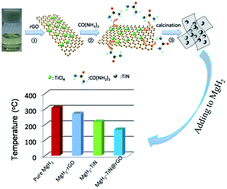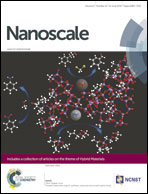Facile synthesis of TiN decorated graphene and its enhanced catalytic effects on dehydrogenation performance of magnesium hydride†
Abstract
TiN@rGO nanohybrids were successfully synthesized by a simple “urea glass” technique. Experimental results demonstrated that TiN nanocrystals, with an average particle size of 20 nm, were uniformly anchored onto highly reduced graphene nanosheets. The as-synthesized TiN@rGO nanohybrids showed a porous planar-like structure, which had a large surface area of 177 m2 g−1. More importantly, the as-prepared TiN@rGO hybrids showed enhanced catalytic effects on the dehydrogenation of MgH2. The dehydrogenation thermodynamics and kinetics of the MgH2–TiN@rGO composites were systematically investigated and some significant improvements were confirmed. It was found that the 10 wt% TiN@rGO doped MgH2 sample started to release hydrogen at about 167 °C, and roughly 6.0 wt% hydrogen was released within 18 min when isothermally heated to 300 °C. In contrast, the onset dehydrogenation temperature of the pure MgH2 sample was about 307 °C, and only 3.5 wt% hydrogen was released even after 120 min of heating under identical conditions. In addition, the catalytic mechanism of TiN@rGO on the dehydrogenation of MgH2 was discussed using the Johnson–Mehl–Avrami (JMA) model and X-ray diffraction equipment.


 Please wait while we load your content...
Please wait while we load your content...